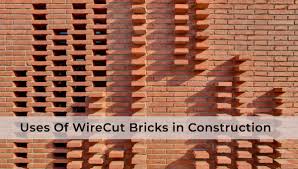What are Wire-Cut Bricks?
Wire-cut bricks, also known as extruded bricks, are machine-made clay bricks that are manufactured using a mechanized extrusion process. A stiff mixture of clay is pushed through a rectangular die to form a long column. This column is then cut into individual bricks using wires, like slicing a loaf of bread.
This process creates bricks that are:
-
Perfectly uniform in size and shape
-
Smooth in texture
-
Stronger and denser than traditional handmade or chamber bricks
How Are Wire-Cut Bricks Made?
-
Clay Preparation:
-
High-quality clay is mixed with a small amount of water.
-
Additives may be added for color, strength, or texture.
-
-
Extrusion:
-
The clay mixture is pushed through a metal die to form a continuous slab or column of brick-shaped material.
-
-
Wire Cutting:
-
The long clay column is cut into brick-sized pieces using steel wires stretched across a frame.
-
-
Drying:
-
The bricks are air-dried or placed in a drying chamber to remove moisture.
-
-
Firing:
- The dried bricks are fired in a kiln at 900–1100°C, making them hard, durable, and weather-resistant.
Also Read: Difference Between Red Brick and ACC Blocks
Properties of Wire-Cut Bricks
| Property | Description |
|---|---|
| Size Uniformity | High – consistent shape and sharp edges |
| Strength | High compressive strength (often > 10 N/mm²) |
| Density | High density – reduces water absorption |
| Surface Finish | Smooth and clean – ideal for exposed walls |
| Color | Uniform, but can vary based on clay type and firing |
Benefits of Using Wire-Cut Bricks in Construction
1. Superior Strength and Durability
-
Suitable for both load-bearing and non-load-bearing walls
-
Long-lasting and resistant to weathering and cracks
2. Neat Construction and Alignment
-
Because of their uniform size and shape, wire-cut bricks lead to:
-
Perfectly aligned walls
-
Less usage of mortar
-
Faster construction speed
-
3. Ideal for Exposed Brick Finish
-
Their smooth surface and consistent color make them perfect for aesthetic walls without plaster or paint.
-
Common in high-end homes, villas, resorts, and commercial buildings.
4. Low Water Absorption
-
Reduces moisture penetration
-
Minimizes problems like damp walls, efflorescence, and mold growth
5. Less Plaster and Paint Cost
-
For exposed brick structures, no plaster or paint needed — saving costs and maintenance in the long run.
Where Are They Commonly Used?
-
Premium residential apartments and villas
-
Commercial buildings with exposed brick facades
-
Garden and landscape walls
-
Compound and boundary walls
-
Schools and institutional buildings for aesthetic look
Disadvantages of Wire-Cut Bricks
-
Higher Initial Cost
-
Costlier than chamber bricks or handmade bricks
-
But long-term durability balances the cost
-
-
Heavier Weight
-
Denser, so they may require stronger foundations
-
-
Needs Skilled Labor
-
Especially for exposed brick finishes (without plaster), alignment and joint filling must be perfect
-
-
Limited Color Choices
-
Usually comes in earthy tones unless custom clay or additives are used
-
Construction Use Case Example
-
Project Type: Premium Villa in Chennai
-
Usage: External exposed walls
-
Result:
-
Beautiful natural look
-
No need for exterior paint
-
Long-lasting and low maintenance
-
Better thermal insulation
-
Using wire-cut bricks in construction is a smart and modern choice for builders who want:
-
High strength
-
Clean aesthetics
-
Long-term durability
-
Cost-effective maintenance
They are particularly suited for projects where quality, speed, and visual appeal matter. While the initial cost may be slightly higher, the returns in longevity and appearance make it a valuable investment.
https://www.livehomes.in/blogs













